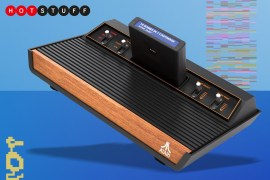The perfect gaming interface: your heart
The time has come to put not only your soul into a game – but also your heart…

One of the stupidest things I’ve ever done is walking into a bathroom and almost having a heart attack colliding head first with another person as they left. As I moved my hands up to apologise, they did the same, and for a brief second my mind – fuelled by a lifetime of violent action movies – thought that I was about to be attacked.
It was in the Gherkin after all – London’s iconic skyscraper. Perhaps a double agent had mistaken me for one of Boris’ assistants and was looking to infiltrate the offices of the floppy-haired London Mayor by stealing my identity.
What actually occurred was far more boring. I turned a corner and walked head-first into a full length mirror. In my defence, it was a stupid place to have one but that didn’t stop the brief spike of adrenaline from kicking my heart into overdrive.
The reason for this embarrassing, barely-relevant anecdote is because a) I’ve been meaning to get it off my chest for some time and b) I’ve been thinking about hearts and their potential role in video games.
READ MORE: Why the smart money is on CDs?
I’m not referring to pixellated hearts which top up virtual health bars. I’m talking about the miraculous 100% home-grown pump that, as you read these very words, is delivering a steady flow of oxygen to all the cells in your body. Hopefully.
Runners measure their heart rate with fancy watches because it acts as a guideline for how hard they should push themselves.
Often beginners push themselves too hard when exercising, which is why people give up after their first running/living-room cardio session. There are also those who don’t push themselves hard enough, which means they plateau without actually getting any fitter.
Keeping within a set heart-rate range ensures you find the right balance, gradually improving your fitness without damaging yourself. Microsoft’s Xbox One has a Fitness app that features a bunch of home workouts designed to help melt calories away.
Its infrared Kinect camera can actually measure your heart rate by detecting minute changes in the colour of your skin as your heart pumps. That means you could use it to ensure you’re pushing yourself the right amount during a workout.
But what about gaming? Imagine a sports game which lets you jog on the spot do star jumps etc, with your speed controlling your on-screen superstar. A training mode gradually ups the intensity and you can see your fitness improvements mirrored in virtual world records.
READ MORE NEW PERSPECTIVES: promoted
Five analogue things digital failed to kill
Too sensible for you? How about: intelligent horror
I’m an utter wimp when it comes to horror games. Headshotting aliens in Halo and Destiny? No problem. Trapped in an abandoned mental asylum littered with the howling spirits of little girls with long black hair however?
No. No thank you. That doesn’t mean I can’t see the potential of using our heart rates to create intelligent horror games. Using a camera like the Kinect, or even a connected smartwatch with a built-in heart rate monitor like the upcoming LG G Watch R, horror games can bring out the scares at the best possible time.
If your heart rate is normal, thanks to your impressive steely nerves, then that will be the perfect queue to ram a wailing banshee in your face the next time you open a door. It can work with puzzles too. Imagine if the next Call of Duty title has a level in which you have to diffuse a bomb solving a puzzle and cutting the right wires.
The faster your heart rate, the shakier your on-screen hands become and your vision could blur, rewarding calm nerves with becoming a hero.
I <3 games
These are just a few suggestions I’ve thought up during my mind-numbing commutes. Game developers are far cleverer and will be able to use our heart-rates in amazing, innovative ways. As long as they weave it in intelligently without making it a gimmick, it will make for a more immersive gaming experience. And I can’t wait.



